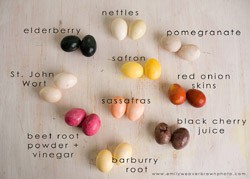Putting Your Eggs All in One (Dye) Basket
A year after an egg-based impromptu family science exploration, this science mom prepares for the next phase of her family's hard-boiled egg and dye bath testing: natural dyes.

The process of hard-boiling and dyeing eggs offers a great chance for informal, at-home, science exploration. The eggs shown above were dyed using an assortment of natural ingredients and showcase a range of colors that can be achieved by experimenting with fruits, plants, and spices. Image: Emily Weaver Brown, used with permission.
My hastily scrawled grocery list over the weekend included eggs and egg dye. After a count of eggs still in the fridge, I ended up not getting the eggs, but I did check out the choices of dyes available at the store. Surprisingly, there are not that many options. Commercial egg dyeing kits seem to not have changed dramatically in the last decade. You can tie-dye your eggs, shrink wrap them in plastic wrappers, draw on them with a white crayon before dropping them in their dye baths, or use stickers, glitter, and glue for added visual boost—or to disguise splotchy dye-jobs or fingerprints created by impatient hands.
A More Natural Approach
Studying the boxes on the display in front of me, I recalled my excursion into depths of egg boiling last year—and a photo I used of beautiful eggs dyed with natural ingredients like beets and tumeric. Underwhelmed by the sticker and glitter-approach to decorating eggs lining the shelves, I thought, with rising conviction, of the deep, rich, natural tones of the eggs I spotted last year and decided we should try it.
I picked up a slimmed down set of cups and tablets, just in case. But it doesn't take much searching to realize that there is a lot of potential in natural dyeing. The Martha Stewart site has a short list of favorite ingredients for natural dyeing, from onions to coffee. The Better Homes and Gardens site contains an extensive flower-, fruit-, spice-, and vegetable-based list of All-Natural Easter Egg Dye Recipes. Finally, for the visual-minded (like me), the photos in this blog post show the sheer range of wonderful tone and hue possible with natural dyeing. The post also dives into the science behind the dyeing, with particular attention to the pH of the ingredients and dye baths, which is critical to the uptake of the dye and the intensity of color you'll see (even with commercial tablets).
(I forgot to get white vinegar. I think they really should put it next to the dye packs for convenience!)
A Lifetime of Icky Green Hard-boiled Eggs
In the course of a year, we don't boil that many eggs. Deviled eggs and egg salad aren't foods commonly found in our fridge or on the table. Basically, once a year, I'm faced with the task of boiling a few dozen eggs for Easter—hoping they don't crack and ooze in the process.
Last year I documented our initial impromptu investigation and our quest for the perfect technique for hard-boiling an egg. We defined the golden chalice of our search as eggs that were not cracked, were yellow inside instead of sickly green, and were, on the whole, less stinky. We then moved from testing hard-boiling techniques to exploring the role of vinegar (and acidity) in the dyeing process. I chronicled the story of our eggs, and our informal scientific study, on the Science Buddies blog. After all, moments and activities like these are wonderful opportunities for family science. And now, here it is, egg-dyeing time again.
Last year's blog post gives me a roadmap for repeating and extending our testing this year with my young scientists. If I can gather the ingredients, I think we'll try the natural dyeing approach this time around, too. And then, we'll stack the eggs in a bowl—leaving them out for no more than two hours—and enjoy filling, hiding, and re-hiding plastic ones. We basically dye a dozen or so "just because"!
Making Connections
If your family will be dyeing or boiling eggs this month, there are a number of related questions you might ask and experiments you might consider. The following project ideas and resources give you additional chickenfeed as you build a stockpile of egg-related topics of conversation, perfect for talking over while you wait for the eggs to take on rich color:
- Egg-cellently Cooked Eggs: The Process of Soft-Boiling an Egg: What's the best way to soft-boil an egg? (Note: this project offers an excellent procedural blueprint for doing a more formal investigation of hard-boiling techniques.)
- Egg Substitutes: What role does an egg play in cooking? Can artificial eggs work equally well?
- Eggs and Hen's Diet: Can You Get Bigger Eggs for Peanuts?: Is there a relationship between what goes into the chickenfeed you use and the size of the eggs produced? What additives make a positive difference in egg size?
Categories:
You Might Also Enjoy These Related Posts:
- 15 STEM Gifts & Science Kits You'll Feel Good About Giving
- 13 Boat Science and Submarine Science Projects and Experiments
- July 4th STEM! Summer Science Picks for Independence Day!
- 12 Science Kits for Summer Science Experiments and Discovery
- 15 Science Projects to Make and Give for Father's Day
- Ready, Set, Go! (Awesome Summer Science Experiments)
- Awesome Summer Science Experiments
- 10 STEM Activities with Cardboard Tubes









